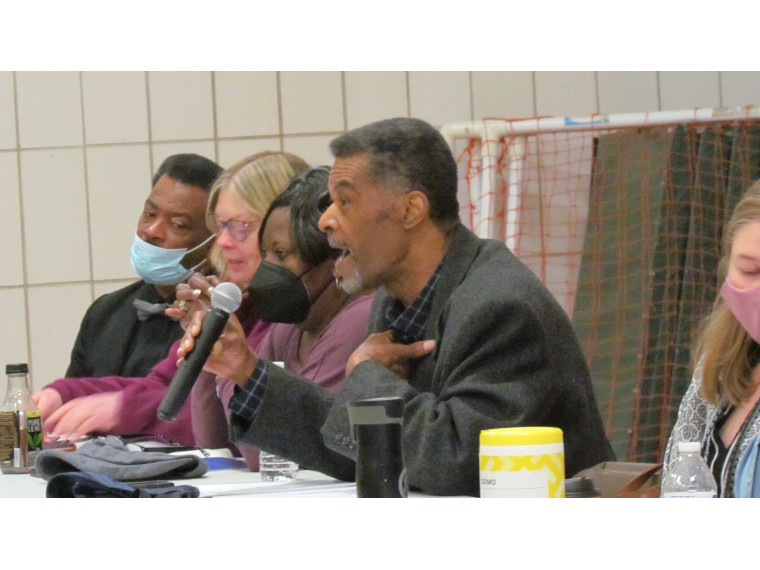Featured photo: Council members listened and talked to community members at community input meeting, but this was only the first input phase concerning the spending of Flint’s ARPA dollars. Council President Eric Mays speaks here before speaking with the Courier.
Written by Tanya Terry
Flint City Councilman Eric Mays, who was the former council president, told the Courier he can see between $10-30 million in ARPA (American Rescue Plan Act) funds going towards reducing crime and blight, which have both been expressed to be major concerns of Flint residents.
“We’ve been facing issues with crime every day, and we’re blessed with an opportunity to abate some of it…”Mays said.
Mays is recommending a process for those wishing to provide input at this point on how the city should spend its remaining approximately $90 million in ARPA funds. Mays created a form, which the Flint City Council voted on, and that residents can get from the Flint City Council office on the third floor of Flint City Hall for this purpose. Each form will become part of the official record for the city of Flint, according to Mays.
“We’ll transfer those forms over to Ernst & Young, the compliance firm, and we’ll see what qualifies,” he said. “Then, we’ll come back and we’ll vote on it.”
The form asks residents for their name, address, contact information and whether they are providing the input as an individual, on behalf of a nonprofit or on behalf of a for-profit. They will also be asked to write their narrative and the amount of money being requested for the purpose. A signature will be required.
The city has up to four years to spend the money.
“I would encourage people to apply, and I would encourage the council and the mayor to start spending some of that money,” Mays said.
Community meetings were held by the city of Flint and Flint City Council for the first input phase.
“Repeatedly, we hear about crime prevention and blight.”

At the fourth in a series of four Community Meetings held on the north, south, east and west side of the city by the Flint City Council, held for the purpose of receiving community input on the potential spending of ARPA funds, spending the money to help reduce crime in our community was a common theme.
The first speaker during the public comment portion of the meeting identified himself to be Jerin Sage and to be serving as the interim director of placemaking for downtown Flint. He said he was advocating for all the artists in the community. He said he thinks about community gatherings that push the violence away and about the murals that cover up the dilapidation.
“…If you want less crime, if you want less blight, you have to have more creativity, “Sage said.
Besides asking for a 5% percentage of the funds to go towards local arts programming, he asked the council to consider the possibility of Flint having a permanent, walkable, immersive art exhibit.

Another individual who spoke during public comment said she lived in Beecher, but cared deeply about Flint, as a former Flint resident. The speaker said besides seeing downtown prosper, she would like to see all the other wards in the city prosper. She said her children were taught to play chess in kindergarten while attending Flint Community Schools many years ago.
“I’d like to see programs like that, like maybe chess in the park,” she said.
The Beecher resident, who also said some of her family members still reside in Flint, said if there were more activities for the residents, it is a possibility there would be less crime.
“They won’t have so much idle time on their hands,” she continued.
Residents talked about programs that teach people about everything from job skills, to financial literacy to how to effectively parent in a pandemic.
“If we give them something to look forward to, maybe crime will go down,” one speaker said.
Denise Diller, executive director of Crossover Outreach, said when people have their basic needs met it helps with value and reduces crime.

Claire McClinton, who attended multiple community input meetings, suggested talking to those who are incarcerated to gain a whole new perspective on how to reduce crime.

Mays pointed out last year he tried to move between $10-12 million for crime prevention.
“We’ve got over 8,000 complaints backlogged in the detective bureau,” he said. “I don’t care if we have to hire civilians to sort through that.”
He said residents who call 911 don’t want to hear police are tied up in a shooting and don’t have personnel, and a big campaign to recruit was needed.

So far, a million dollars of the $94 million in ARPA funds has been spent on a compliance firm, and between $2.6-3 million had been already allocated for essential workers premium pay.
During COVID-19 the federal government decided to send about $94 million to the city of Flint.
Using a portion of the funds to build affordable housing in empty lots, having a business incubator in each ward to help budding entrepreneurs and making improvements to Flint City Hall were also suggested, along with other ideas.


